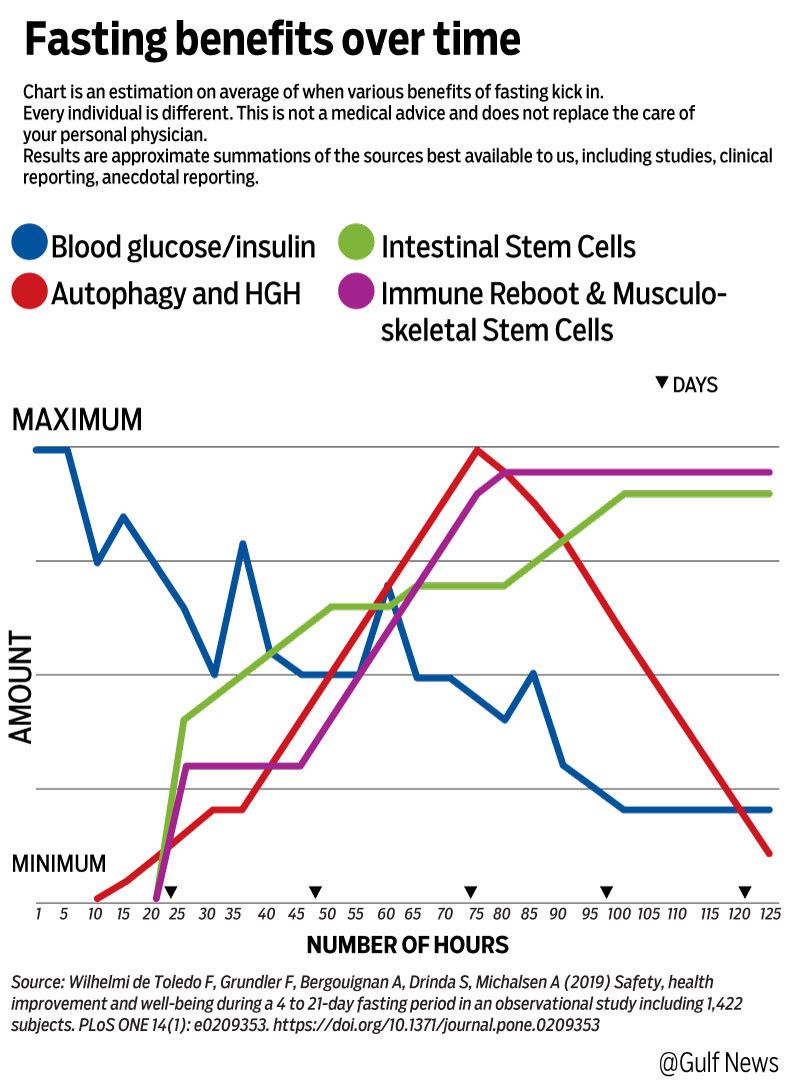Fasting is the new trend in town. Or is it just a fad? Since when did UAE residents start turning their faces away from food?
UAE is a second home to more than 200 nationalities who work and live here. All of these nationalities have brought to the UAE their own cuisine, making it the culinary capital of the world, in terms of sheer size, variety and per square metre availability. There is no denying the fact that the average UAE resident spares no second thought when it comes to eating out or testing out a new dish. However, more and more people you meet are talking about fasting as a new pursuit as much as eating. It is as though they have found a new balance in life. We enquired and this is what we found.
Fasting and health: Let’s start with the basics
Shyam Krishna, Senior Associate Editor
What’s fasting?
Fasting is abstaining from eating food for a specific length of time. The human body is well equipped to handle extended periods without food. Humans must have been fasting since they were around. Most of the time, it was done out of necessity when food wasn’t available. When there was adequate food, fasting has been used for therapy and as spiritual practices in several religions. Now, fasting has been used for maintaining fitness and weight loss.
How’s fasting linked to medicine?
Fasting is one of the oldest medical therapies. It is used in many ancient healing systems since fasting allows the body to rid itself of toxins that are responsible for several ailments. Greek physician Hippocrates, the father of modern medicine, said that fasting helped the body to heal itself.
How does fasting work?
When the intake of food is stopped for a certain period, many organs and systems of the body will not have to work on digestion. So the energy saved from the digestive process is used to repair the body, thereby healing it. The liver and immune system are freed to detoxify and heal the body. It also allows the body to burn the stored calories.
What are the benefits of fasting?
Many studies have shown that fasting can help reduce weight, improve metabolic health, protect against ailments, including heart disease, Type 2 diabetes, some forms of cancer, and Alzheimer’s. Besides, there’s the promise of a longer, healthier life. During fasting, there’s also a significant reduction in blood sugar and insulin levels, besides a sharp spike in human growth hormone.
Although fasting is recommended, medical advice has to be sought before starting any form of fasts. The various kinds of fasting may not work for everyone, and some people may require a tailor-made plan. So it’s best to consult a healthcare professional before starting a fast.
Intermittent fasting
It is one of the more popular forms of fasting and is currently a health and fitness trend. Simply put, it’s alternating cycles of fasting and eating. But the duration of fasting differs in each version. So these are time-restricted eating plans.
Intermittent fasting has been used as a weight-loss tool, but it doesn’t work for everyone and is not recommended for people with eating disorders. Is very important to consume nutritious food during the eating periods, and avoid excessive calorie intake.
read more
There are several approaches to intermittent fasting, but we have focused on nine of them.
1. Fast for 12 hours a day
It’s fasting for 12 hours and the remaining 12 hours is a window for eating before resuming the fast. According to researchers, this diet could persuade the body to turn its fat stores into energy and release ketones into the bloodstream. And that should encourage weight loss.
2. Fasting for 16 hours
Known as the Leangains protocol, it involves fasting for 16 hours, and the daily eating window is restricted to 8-10 hours. It’s easier to follow if you don’t eat anything after dinner and skip breakfast the next day. The method, structured by fitness expert Martin Berkhan, permits drinking water, black coffee, black tea (a splash of milk is allowed) and other zero-calorie beverages during the fast.
The weight loss in this diet is also triggered by ketosis. During the 16-hour fast, glycogen in the liver is depleted, and the body slips into ketosis. Leangains includes exercise into the fasting period to increase the rate of burning fat.
3. Two-day fast a week
Called the Fast Diet after the book authored by Michael Mosley and Mimi Spencer, it allows regular food intake for five days of the week, but for the remaining two days the calorie intake is reduced to 500–600. The 5:2 diet prescribes lean protein, vegetables, and fruit on fasting days as two small meals and snacks. On the other five days, you can eat almost anything.
4. Alternate-day fasting
It’s simple: You fast every other day. Fasting for a full day may seem extreme and could be unsustainable. Some variations allow for an intake of 500 calories during the fasting days. Several studies have shown the benefits of this method, popularised by Krista Varady, a nutrition professor at the University of Illinois in Chicago.
An Austrian study last year found that after four weeks of alternate-day fasting, “people had more lean muscle and less body fat, lower cholesterol levels and improved heart health.” All these things can happen with exercise and nutrition programmes, according to a Reuters report.
Also read
5. Weekly 24-hour fast
This Eat-Stop-Eat method involves a 24-hour fast once or twice per week. Water, black coffee, black tea and other zero-calorie beverages are allowed during the fasting, made popular by fitness expert Brad Pilon. The only problem is that some people may find it difficult to fast for a full 24 hours.
6. Meal skipping
This is not a structured fasting plan. It merely involves skipping a meal or two from time to time. So it is a spontaneous intermittent fast.
Health experts say skipping meals is not good since it can lead to tiredness and loss of essential nutrients. It could also trigger snacking on high-sugar foods, resulting in weight gain.
7. The Warrior Diet
The diet, popularised by fitness expert Ori Hofmekler, involves eating small amounts of raw fruits and vegetables during the day and a big meal at night. Which mean you fast during the day and eat during a four-hour window at night. Some recommend the food to be mostly whole grains and unprocessed, while others advise the consumption of plenty of vegetables, proteins, and healthful fats, besides some carbohydrates. Hofmekler believes the plan mimics the pattern of ancient warriors, hence the name.
8. One Meal A Day
Known by the abbreviation OMAD, this is a weight-loss plan in which a person eats only one meal per day and fasts the rest of the time. It’s also called 23:1 diet since people fast for 23 hours and eat for one hour. This diet may help some people lose weight, but it may also carry some risks, according to Medical News Today. Low sugar levels could result in fatigue, increased irritability and trouble in concentrating. The risk of binge eating at a single meal time is also high.
The diet also presents a significant problem for people who take prescription medications with food more than once per day.
9. A 48-hour fast
In a 48-hour fast, you take a full, two-day break from eating. During the two-day fast, you can drink water, black coffee, black tea and zero-calorie fluids. It’s essential to drink plenty of fluids to prevent dehydration. At the end of the fast, food should only be consumed gradually, starting with a small snack. On non-fasting days, it is advised to avoid very high-calorie foods. The 48-hour fast is generally done only once or twice a month.
First person: From health condition to reinvented self
Sonia Shah, Videographer
I was 29 years old when I was diagnosed with Hashimotos, an autoimmune disease which causes your thyroid to have a low function. Because of that I started to gain weight and suffered from other medical conditions. My doctor suggested that I should try doing intermittent fasting (IF).
Being a Muslim, I am used to fasting but making such a change to your body isn’t easy. The first few days of IF were really hard I had terrible headache at the end of my fasting window. But eventually it got easier. I started my journey from 16:8 which is 16 hours of fasting and 8 hours of eating.
Then I eventually moved onto 20:4 and now two years of being on this journey I do OMAD (One meal a day). I sometimes do more than 24hrs of fasting which is very beneficial as your body goes into autophagy mode. During this process the cells break down viruses, bacteria and damaged components.
After two years of fasting, I can say that IF has really helped me in various ways: my thyroid function is normal, I have more energy now and I feel healthy and I have lost 15kg in total. For me, fasting was not at all about losing weight but also to get my health and fitness under control.
Recently my brother was diagnosed with Type 2 Diabetes and the doctor suggested that he try IF. Eventually his diabetes reversed and today he is diabetes free.
For everyone reading my story, I would say that please consult your doctor first before starting your IF journey, just as I did before trying it.
I love fasting, to me it isn’t some fad diet but a lifestyle that has changed my body for the better.
First person: My journey with fasting
Sara Shurafa, Assistant Online Editor
In January this year, I had decided that 2020 will be the year that I will be regaining my healthy self. In the past years, with two pregnancies, and an unhealthy level of stress and juggling lifestyles, I had lost track of my healthy way of life. Therefore, I decided to start looking at options to get my health back on track. At that point, I did not have any serious health problems, but my BMI was high, with a bad IBS that led me to be on painkillers most of the time, besides my lack of energy and my low morale.
For me, a healthy person is someone who is full of energy. I was lacking in that no matter how much sleep I got or how much I ate trying to get my energy levels back.
I’d heard a lot about intermittent fasting and how many people on it were losing weight. It intrigued me to take a serious look into it. Whenever I asked anyone who is doing IF, the answers were positive: that it helped them lose weight. However, I was more concerned about the long-term health benefits. Finally, I reached two fundamental conclusions that made me start Intermittent Fasting
I have read in many papers that when your body is not working to digest food, it works on repairing cells. Which could also mean that, during this period, your body takes care of some of the cells that could later become cancerous. Fasting also meant that you will be eating less sugar and fewer calories. As a result, you will be losing weight, which also meant that your risk of obesity and diabetes became lower.
I’ve been fasting now 12 to 16 hours a day, for more than 6 months now. Fasting didn’t just make me lose weight, but today I have so much more energy to work, to look after my kids and to even exercise and socialise. I am more focused now. I do not feel sluggish any more, neither do I feel angry or depressed. My digestive system is much better, and my hunger prangs and sugar rush are gone.
Fasting has made me a better person at all levels; it has made me calmer and more patient.
Fasting should be followed under professional guidance: Juliott Vinolia
Suchitra Bajpai Chaudhary, Senior Reporter
In the early 90s, the diet mantra to boost metabolism and burn fat was to consume “small frequent meals” of up to 5 small meals per day for sustained energy levels. Over the years, with our busy lifestyles, we have highly compromised on our diet and lifestyle, which has gotten worse during these pandemic times. We were unknowingly eating a diet excess in calories compared to our energy expenditure and also inadequate in vital nutrients putting us all at risk of chronic diseases, inflammation and poor immunity.
Most of our foods today come with hidden calories more than what we need- making our bodies vital disease preventing and energy sustaining functions sluggish. With the era of weight loss trends, fasting has taken more light in the area of research with the focus light on boosting our metabolism while managing work fatigue and preventing obesity.
Though research has clearly set out the benefits of autophagy and fasting in the evolution of the Super Human, we should understand that fasting directly impacts us at cellular level and should be followed under professional guidance to prevent any irreversible damage to health. Before following any type of fasting whether intermittent, time- restricted or alternate day fasting we have to first make sure we are medically fit to proceed in order to gain full benefits of autophagy in reviving good health.

What Ayurveda says about fasting
Biju Mathew, Online Editor
Ayurveda, the ancient Indian system of medicine, advocates fasting as a means of healthy living and to cure many ailments.
“Ayurveda suggests fasting for the treatment of several diseases. Fasting or upavasa is one of the most effective biological methods of treatment for several diseases. Our medicine should be our food. But to eat when you are sick is to feed your sickness,” said Dr. V. L. Shyam, a UAE-based licenced alternative medicine practitioner, who runs Dr Shyam’s Ayurvedic Centre in the country.
Ayurveda recommends eating between 10am and 6pm with sufficient intervals, which leaves 16 hours of fasting time. According to Ayurveda, one may take breakfast around 10am, lunch by mid-day and dinner before the sunset, said Dr Shyam.
But fasting should have its regulations too, Dr Shyam cautioned. “As per Ayurveda, hunger is a natural urge, which shouldn’t be suppressed, nor pre-initiated nor overfed. Eat light while hungry is what is proposed by Ayurveda for a healthy individual. Suppression of hunger can result in body pains and aches, anorexia, debility, emaciation, weight loss, abdominal colic pain and delusion.”
Is there a particular diet recommended by Ayurveda?
Dr Shyam, highlighting the benefits of eating right, said: No food is good or bad. Everything needs to be eaten in moderation.
According to Ayurveda, certain food types should not be consumed habitually:
- Sweet dairy products
- Yoghurt
- Solid part of curds (paneer/cheese)
- Alkaline foods
- Vinegar
- Uncooked radish
- Meat of emaciated animals
- Dry meat, meat of lamb, cow, fish, buffalo
- Black gram, amarakka (broad beans, fava beans), chempu (colocasia),
- Lotus root, sprouts, dried vegetables, small barley, jaggery.
Ayurveda also recommends certain food types that should be included on a daily basis:
- Red rice, shashtikashali (rice grown in 60 days)
- Wheat, barley, green gram
- Rock salt, amla (gooseberry), rain water
- Ghee, cow milk, honey
- Meat of animals from arid land, four leaf clover
- Unripe radish, grapes, snake gourd, sugar, pomegranate
- Triphala with honey or ghee
Ayurveda recommended discipline of eating food
- On proper time
- The food which is habituated
- Clean and hygienic
- Suited for health
- Oily and warm
- Light and easily digestible
- Consume with attention
- Having all 6 tastes (sweet, sour, salty, spicy, bitter and astringent); at the same time predominance of sweet taste
- Eat neither very quickly nor very slowly
- Eat after taking bath
- Eat only after having good hunger
- Eat without abusing food
- Eat without talking
Fasting through history
Jay Hilotin, Senior Assistant Editor
In both men and mice, numerous studies have found that curbing food intake helps.
Fasting has been used and observed for thousands of years. It was seen as one of the oldest therapies in medicine. Great doctors of ancient times and many of the oldest healing systems have recommended it as an integral method of healing and disease prevention.
There’s an ancient wisdom behind it: Among the earliest records of fasting involved the ancient Romans, who apparently found the idea of “breakfast” repulsive. They were “obsessed with digestion,” historian Caroline Yeldham stated. The Romans seemed to believe eating more than one meal a day was gluttonous — even unhealthy. Some researchers argue that’s one of the early starts of what’s now known as “intermittent fasting”.
Hippocrates, the father of Western medicine, believed fasting enabled the body to heal itself. Paracelsus, another great healer in the Western tradition, wrote 500 years ago that “fasting is the greatest remedy, the “physician within”.“ Ayurvedic medicine, has long advocated fasting as a major treatment. In ancient Greece, Pythagoras was among many who extolled its virtues.
Dr Herbert Shelton 1895-1985) was a revered pioneer of “therapeutic fasting” — in which fasting is used to either treat or prevent ill health, with medical supervision. It became popular in the 19th century as part of the “Natural Hygiene Movement“ in the US. “Dr Shelton He claimed to have helped 40,000 patients recover their health with a water fast.
Many scientific studies had been done on fasting, starting from the early 1900s. A 1986 study published by Metabolism (Elsevier) ked by G.L. Burke on 3,313 children ages 5-17 years showed that fasting insulin levels are positively related to measures of obesity, systolic and diastolic blood pressure, triglyceride, β-lipoprotein cholesterol and pre-β-lipoprotein cholesterol levels.

2009 Carmela study
If you’re 55 or older, fasting may bring benefits, according to a 2009 study led by Dr Jorge Escobedo and his team. The so-called CARMELA (Cardiovascular Risk Factor Multiple Evaluation in Latin America) study was done to estimate the prevalence of Type 2 diabetes, “impaired fasting glucose” and related risk factors in seven urban Latin American populations. The study was one of the largest, and included 11,550 adults 25–64 years of age, with 1,600 subjects were randomly selected in each city.
The results of CARMELA: Overall, the study found that prevalence of diabetes was 7.0%. One important bit: it found that the prevalence of individuals with diabetes or impaired fasting glucose increased with age. For example, they found that in the oldest age category (55–64 years), prevalence of diabetes ranged from 9 to 22%, while prevalence of impaired fasting glucose ranged from 3 to 6%.
Among diabetics, 83.7% had impaired fasting glucose — i.e. only 16.3% of people with prior diagnosis of diabetes and who were receiving diabetes medication, were in “good” glycemic control (fasting glucose < 6.1 mmol/l). Most important: the study found that the prevalence of diabetes in individuals with abdominal obesity was about two-fold higher. Participants with hypertension, elevated serum triglycerides and increased common carotid artery intima‐media thickness were also more likely to have diabetes.
2019 Feel-good trial
A 2019 study led by Rachel Washburn of Texas Tech University on intermittent fasting (IF) effects (24-hour water-only fasting), known as the “Feel-good trial”, focussed on trimethylamine N-oxide (TMAO) levels measured due to their association with elevated risk of coronary artery disease,
During the fasting period of the study, researchers found that TMAO levels were substantially decreased during the fasting day compared to the fed day. “TMAO is a novel and exciting biomarker of cardiovascular disease in humans that arises from intestinal microbiota,” the researchers wrote. “Due to its connection to dietary intake, TMAO is also a good candidate to be affected by intermittent fasting, and its change highlights the possibility that fasting may also beneficially alter the microbiome at least during caloric desistance, if not for a more extended period of time after the end of a fasting episode.” The key: “caloric desistance”, i.e. no food.
2019 Buchinger Fasting trial
In 2019, PloS journal published a clinical on fasting, with 1,422 participants. It was one of the few studies that documented longer periods of fasting (one year) in a large number of participants, including non-obese people.
The Franco-German research team led by Françoise Wilhelmi de Toledo documented the safety and changes in the participants’ basic health and well-being indicators.
To measure blood lipids, glucoregulation and other health-related blood parameters, blood tests before and at the end of the fasting period were done. It also used pre-post analysis using mixed-effects linear models.
The observational study ran for one year following the Buchinger periodic fasting (4 to 21 days of fasting periods, during which participants were limited to 200–250 kcal of daily caloric intake). The study subjects included 404 people with pre-existing health complaints, including diabetes and obesity.

Startling Results
De Toledo’s study asked the participants to do a moderate-intensity lifestyle program, including regular exercises, with clinical parameters and adverse effects and well-being documented daily.
The results were startling: Among the 404 subjects with pre-existing health-complaints, 341 (84.4%) reported an improvement — significant reductions in weight, abdominal circumference and blood pressure in the entire group.
At the same time, 93.2% of the subject reported an absence of hunger feeling. Statistically, this type of fasting proved safe: Among the 1,422 study participants, only 1% reported adverse effects.





